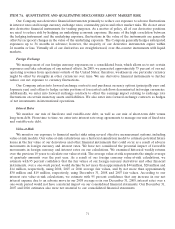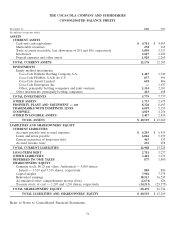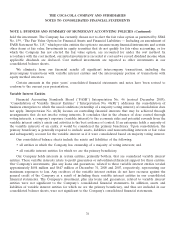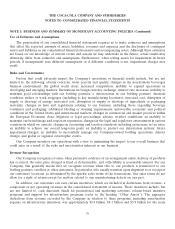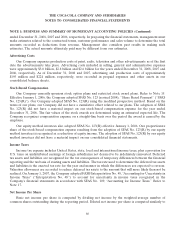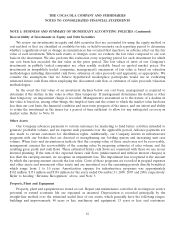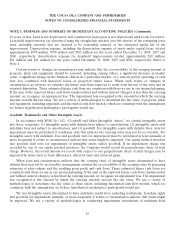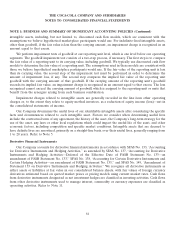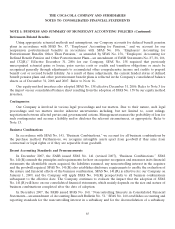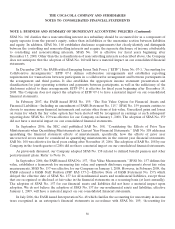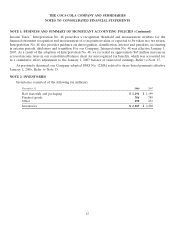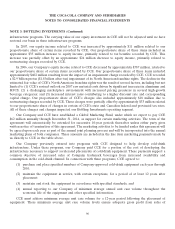Coca Cola 2008 Annual Report Download - page 82
Download and view the complete annual report
Please find page 82 of the 2008 Coca Cola annual report below. You can navigate through the pages in the report by either clicking on the pages listed below, or by using the keyword search tool below to find specific information within the annual report.THE COCA-COLA COMPANY AND SUBSIDIARIES
NOTES TO CONSOLIDATED FINANCIAL STATEMENTS
NOTE 1: BUSINESS AND SUMMARY OF SIGNIFICANT ACCOUNTING POLICIES (Continued)
ended December 31, 2008, 2007 and 2006, respectively. In preparing the financial statements, management must
make estimates related to the contractual terms, customer performance and sales volume to determine the total
amounts recorded as deductions from revenue. Management also considers past results in making such
estimates. The actual amounts ultimately paid may be different from our estimates.
Advertising Costs
Our Company expenses production costs of print, radio, television and other advertisements as of the first
date the advertisements take place. Advertising costs included in selling, general and administrative expenses
were approximately $3.0 billion, $2.8 billion and $2.6 billion for the years ended December 31, 2008, 2007 and
2006, respectively. As of December 31, 2008 and 2007, advertising and production costs of approximately
$195 million and $224 million, respectively, were recorded in prepaid expenses and other assets in our
consolidated balance sheets.
Stock-Based Compensation
Our Company currently sponsors stock option plans and restricted stock award plans. Refer to Note 15.
Effective January 1, 2006, the Company adopted SFAS No. 123 (revised 2004), ‘‘Share Based Payment’’ (‘‘SFAS
No. 123(R)’’). Our Company adopted SFAS No. 123(R) using the modified prospective method. Based on the
terms of our plans, our Company did not have a cumulative effect related to our plans. The adoption of SFAS
No. 123(R) did not have a material impact on our stock-based compensation expense for the year ended
December 31, 2006. The fair values of the stock awards are determined using an estimated expected life. The
Company recognizes compensation expense on a straight-line basis over the period the award is earned by the
employee.
Our equity method investees also adopted SFAS No. 123(R) effective January 1, 2006. Our proportionate
share of the stock-based compensation expense resulting from the adoption of SFAS No. 123(R) by our equity
method investees is recognized as a reduction of equity income. The adoption of SFAS No. 123(R) by our equity
method investees did not have a material impact on our consolidated financial statements.
Income Taxes
Income tax expense includes United States, state, local and international income taxes, plus a provision for
U.S. taxes on undistributed earnings of foreign subsidiaries not deemed to be indefinitely reinvested. Deferred
tax assets and liabilities are recognized for the tax consequences of temporary differences between the financial
reporting and the tax basis of existing assets and liabilities. The tax rate used to determine the deferred tax assets
and liabilities is the enacted tax rate for the year and manner in which the differences are expected to reverse.
Valuation allowances are recorded to reduce deferred tax assets to the amount that will more likely than not be
realized. On January 1, 2007, the Company adopted FASB Interpretation No. 48, ‘‘Accounting for Uncertainty in
Income Taxes’’ (‘‘Interpretation No. 48’’) to account for uncertainty in income taxes recognized in the
Company’s financial statements in accordance with SFAS No. 109, ‘‘Accounting for Income Taxes.’’ Refer to
Note 17.
Net Income Per Share
Basic net income per share is computed by dividing net income by the weighted-average number of
common shares outstanding during the reporting period. Diluted net income per share is computed similarly to
80



